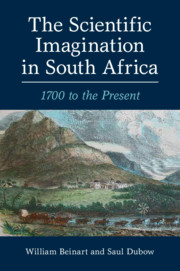Refine search
Actions for selected content:
10298 results in History of science: general interest
Index
-
- Book:
- The Scientific Imagination in South Africa
- Published online:
- 07 May 2021
- Print publication:
- 20 May 2021, pp 398-406
-
- Chapter
- Export citation
Map
-
- Book:
- The Scientific Imagination in South Africa
- Published online:
- 07 May 2021
- Print publication:
- 20 May 2021, pp vi-vii
-
- Chapter
- Export citation
6 - The Republic of Science, 1948–90
-
- Book:
- The Scientific Imagination in South Africa
- Published online:
- 07 May 2021
- Print publication:
- 20 May 2021, pp 264-318
-
- Chapter
- Export citation
Contents
-
- Book:
- The Scientific Imagination in South Africa
- Published online:
- 07 May 2021
- Print publication:
- 20 May 2021, pp v-v
-
- Chapter
- Export citation
Afterword
-
- Book:
- The Scientific Imagination in South Africa
- Published online:
- 07 May 2021
- Print publication:
- 20 May 2021, pp 373-381
-
- Chapter
- Export citation
4 - Science, Reconstruction and the Imagining of the First ‘New’ South Africa, 1902–29
-
- Book:
- The Scientific Imagination in South Africa
- Published online:
- 07 May 2021
- Print publication:
- 20 May 2021, pp 155-206
-
- Chapter
- Export citation
7 - Big Science and Indigenous Knowledge: Post-Apartheid South Africa and the African Renaissance
-
- Book:
- The Scientific Imagination in South Africa
- Published online:
- 07 May 2021
- Print publication:
- 20 May 2021, pp 319-372
-
- Chapter
- Export citation
5 - The Commonwealth of Knowledge, 1930–48
-
- Book:
- The Scientific Imagination in South Africa
- Published online:
- 07 May 2021
- Print publication:
- 20 May 2021, pp 207-263
-
- Chapter
- Export citation
Acknowledgements
-
- Book:
- The Scientific Imagination in South Africa
- Published online:
- 07 May 2021
- Print publication:
- 20 May 2021, pp x-xii
-
- Chapter
- Export citation
Figures
-
- Book:
- The Scientific Imagination in South Africa
- Published online:
- 07 May 2021
- Print publication:
- 20 May 2021, pp viii-ix
-
- Chapter
- Export citation
‘Seeing with one's own eyes’ and speaking to the mind: a history of the Wilson cloud chamber in the teaching of physics
-
- Journal:
- The British Journal for the History of Science / Volume 54 / Issue 2 / June 2021
- Published online by Cambridge University Press:
- 11 May 2021, pp. 177-193
- Print publication:
- June 2021
-
- Article
- Export citation
‘Hong Kong can afford a typhoon or two’: British discussions of revolving storms
-
- Journal:
- The British Journal for the History of Science / Volume 54 / Issue 3 / September 2021
- Published online by Cambridge University Press:
- 11 May 2021, pp. 327-339
- Print publication:
- September 2021
-
- Article
- Export citation

The Scientific Imagination in South Africa
- 1700 to the Present
-
- Published online:
- 07 May 2021
- Print publication:
- 20 May 2021
Anticipating the monsoon: the necessity and impossibility of the seasonal weather forecast for South Asia, 1886–1953
-
- Journal:
- The British Journal for the History of Science / Volume 54 / Issue 3 / September 2021
- Published online by Cambridge University Press:
- 05 May 2021, pp. 305-325
- Print publication:
- September 2021
-
- Article
- Export citation
Chapter 5 - Publishing Princess Elizabeth
-
- Book:
- Princesses Mary and Elizabeth Tudor and the Gift Book Exchange
- Published by:
- Amsterdam University Press
- Published online:
- 09 June 2021
- Print publication:
- 30 April 2021, pp 63-84
-
- Chapter
- Export citation
Chapter 4 - New Year’s Gifts Given and Received by Mary and Elizabeth
-
- Book:
- Princesses Mary and Elizabeth Tudor and the Gift Book Exchange
- Published by:
- Amsterdam University Press
- Published online:
- 09 June 2021
- Print publication:
- 30 April 2021, pp 53-62
-
- Chapter
- Export citation
Index
-
- Book:
- Princesses Mary and Elizabeth Tudor and the Gift Book Exchange
- Published by:
- Amsterdam University Press
- Published online:
- 09 June 2021
- Print publication:
- 30 April 2021, pp 95-97
-
- Chapter
- Export citation
Select Bibliography
-
- Book:
- Princesses Mary and Elizabeth Tudor and the Gift Book Exchange
- Published by:
- Amsterdam University Press
- Published online:
- 09 June 2021
- Print publication:
- 30 April 2021, pp 91-94
-
- Chapter
- Export citation
Acknowledgements
-
- Book:
- Princesses Mary and Elizabeth Tudor and the Gift Book Exchange
- Published by:
- Amsterdam University Press
- Published online:
- 09 June 2021
- Print publication:
- 30 April 2021, pp vii-viii
-
- Chapter
- Export citation
Frontmatter
-
- Book:
- Princesses Mary and Elizabeth Tudor and the Gift Book Exchange
- Published by:
- Amsterdam University Press
- Published online:
- 09 June 2021
- Print publication:
- 30 April 2021, pp i-iv
-
- Chapter
- Export citation
